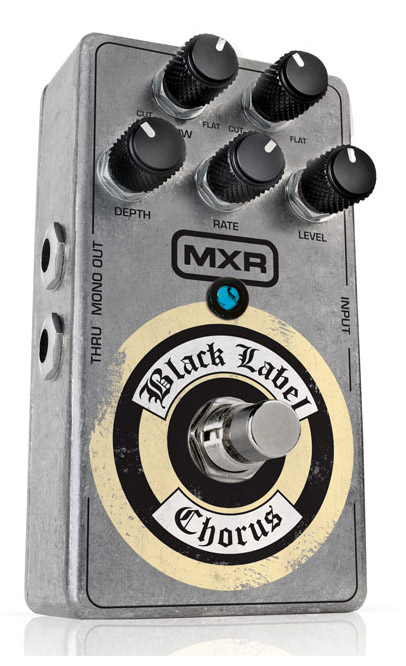exactement, sauf qu'avec une eq programmable, on peut reproduire plusieurs baffles en se basant sur leurs courbes de fréquences (grossièrement).
Chez ADA, les microcab et ampulator avaient l'air terrible dans ce domaine, tout en analogique pour du 1x12, 2x12, 4x12 open ou closed back!
Autre sujet à aborder quand on joue en config parallele: l
e delay pour grossir le son!
C'est une technique bien connu de "doubling", c'est le principe du chorus, on décale de qques millisecondes le son et on le grossis. Au delà de 35ms le cerveau pourrait s'apercevoir qu'il y a deux sons distincts.
Explication technique:
Citation:
The principle of a chorus (doubler) is to apply a short delay, between 20 and 50ms, and to modulate slightly this delay, to avoid hearing two clearly distinct sounds. The listener has thus the feeling of having two instruments merging their sound, but one cannot say where the sound comes from. The final result is a wide stereo image, as if the instrument was not located at a given point, but all along the stage width.
The 20ms to 50ms choice is not an innocent choice. Each time period can be associated to a frequency, by the simple formula F = 1/T. The human perception ranges from, roughly, 20Hz to 20kHz, and the really audible sounds start around 40Hz.
The period of a 20Hz sound is 1/20=0.05s, i.e. 50ms. The period of a 50Hz sound (approximately the lowest note of a bass guitar) is 20ms. In other terms:
A longer delay would make the chorus sound like a very short echo.
A shorter delay would cause sound interferences that would alter the tone of the instrument (that’s the comb filter effect used in the flangers).
I will not address flanging, phasing and the comb-filter principle here. It would be very interesting, but there is actually no effect of that kind in the Rockman line.
Stereo chorus, sometimes called doubling, has played a significant role in the history of SR&D and Rockman.
The Rockman Stereo Chorus, developed on the basis of Tom Scholz original doubler, is the main device used to convert a mono signal into a wide stereo sound, without altering the original instrument tone. The “long chorus” switch available in the Rockman chorus rack units changes the average delay from 20 to 50ms, thus allowing different sonic atmosphere and a deeper stereo effect.
Source:
http://www.rockman.fr/Products(...)s.htm
Utilisateur connu: notre jojo pepet qui peut tuer des gens avec son pedalboard
CItations de lemg du topic materiel pro:
lemg a écrit :
wagner2002 a écrit :
lemg a écrit :
Car n'oublions pas que le TC2290 lui servait essentiellement à grossir le son. Une sorte de doubler/chorus. Il le réglait à 7ms la plupart du temps.
d'après une interview de petrucci le TC2290 lui sert à décaler le son gauche et droite, d'avoir son son en stéréo :
Citation:
John: That album [Awake] was a combination of the Mark IIC+ and the Dual Rectifiers. It’s the only album
where I actually did quadruple tracking. So, when I recorded, if it was a rhythm part or figure, I played two
tracks, left and right, of the IIC+, and two tracks, left and right, of the Dual Rectifier. I still use the [TC
Electronic] 2290. I don’t use the Lexicon piece [PCM 70] anymore. I’m using all TC Electronic stuff now. With
regards to the 2290, I guess I’m just in love with it! I’ll never not have one of those in a rig. I still use that. I use
it mainly for chorusing and for a [stereo] split. I use a 7ms [delay] setting [between left and right speakers] on
pretty much every sound. [Editor’s note: This is a technique utilizing a delay setting whereby one-half of the
signal (either the entire left or right channel) is delayed by a slight amount in order to create the illusion of depth
and space between the speakers. The delay is set 100% wet with 0% feedback so that the entire signal for that
channel is delayed by the set amount with no dry (non-delayed) signal or repeats present]. I don’t really use that
[2290] for echo. Instead, I use a TC Electronic M3000 unit for all of the delays.
source : musicplayer.com
Je sais, j'ai omis les considérations stéréophoniques.
Néanmoins, l'interview de Petrucci ne me donne pas tort.
Et puis comment pensez-vous que je suis au courant ?
@Starfucker : pour Frusciante, le chorus sert certes à dédoubler le signal mais il n'est pas activé en permanence.
Lorsque la pédale n'est pas enclenchée, je ne pense pas que le décalage de quelques milisecondes puisse avoir lieu.
je pose l'hypothèse que frusciante fait pareil avec sa CE1
Et pour conclure, c'est le principe du BBE Sonic maximizer, car en étudiant la puce utilisé, en fait il s'agit d'une puce de chorus, sauf qu'ils l'allient à une EQ. Donc en gros les basses ne vont pas arriver en meme temps que les aigues, ça provoque une meilleur définition dans le son, un son plus précis et intelligible.



